(Created page with "== Advanced Geometry == Now that you've learned the basics switch to the Geometry tutorial by starting a New project (you can click the '''New''' button in the main menu or press '''CTRL-N''') and choosing the '''Geometry''' tutorial and press '''Ok.''' none|thumb|438x438px You will be greeted by many sectors with rooms connected via corridors. Each room will teach you something new about Dark Forces editing. All these lessons are quite...") |
No edit summary |
||
| Line 61: | Line 61: | ||
Finally, you can | Lets go over the icons at the top. | ||
[[File:SCIcons.png|none|thumb]] | |||
* Whenever you make changes to the Sector (or any other Map Component like Walls) your changes must be saved. To do that click the Green Checkmark icon at the top or by pressing '''F3.''' | |||
* You can cancel your changes by clicking the red circle next to it. | |||
* The INF exclamation icon opens up the Scripting Editor - we will go over this in a later tutorial. | |||
* You will also see a "'''Stay on Top'''" checkbox. If it is selected, this window will not be hidden when overlaid by the Map Editor. It's recommended to keep it checked. | |||
* Finally, the question mark icon will bring up WDFUSE help. | |||
==== Flags ==== | |||
Lets quickly explore the Flag Editor. | |||
While having '''STARTSECTOR''' selected, try double-clicking on the '''Flag 1''' option. This will bring up the Flag Edit menu. | |||
[[File:SCFlagEdit.png|none|thumb|463x463px]] | |||
Flags are various options assigned to the Sector. In this particular case, the only option selected is the Exterior. This is because when you look outside you will see the sky. If that flag wasn't checked you will just see a flat texture as your ceiling. Exit out of this menu by pressing the '''X''' in the top right corner. | |||
Just like flags, you can change a texture by double clicking on the texture parameter (Either Floor or Ceiling for a Sector). We will talk about that later in this tutorial. | |||
==== Finding Sectors ==== | |||
To help you navigate , you can find a sector either by name or by numerical ID by pressing the '''F''' key. The search menu will popup allowing you to quickly find your sector. | |||
[[File:FindSector.png|none|thumb|534x534px]] | [[File:FindSector.png|none|thumb|534x534px]] | ||
=== Walls === | |||
=== Vertices === | |||
=== Texture Editor === | |||
When you double click on a texture parameter in a Sector or Wall editor the Texture Resource Picker window will appear. | |||
[[File:Texture Picker.png|none|thumb|1012x1012px]] | |||
On the left you will see a list of textures. These are files that end in '''.BM''' and loaded from '''TEXTURES.GOB .''' When you pick the texture you like, the texture will be rendered in the window on the right. You will also have texture details explained in the top right corner such as the location, size and dimensions of the asset. | |||
Notice that at the top you can also change the texture '''Brightness''' and the texture's '''Zoom''' level. So if the texture is too dark or too small you can always play with those settings to make it easier to view. | |||
When you are done selecting your texture simply click the green checkmark at the top and your texture will be applied. | |||
==== Filtering Textures ==== | |||
In the top left menu you can will see a '''Source''' option. '''Project Dir''' means that the textures are loaded from your WDFUSE project directory. Any BM file you put in that folder will appear in this list. '''User List''' means that the texture is loaded from '''TEXTURES.GOB''' . | |||
You will also see a pull down called '''Available Pick Lists''' . These are nice groupings of textures to help you find the ones you need. You can search for a grouping of '''Walls''', '''Ceilings''' or from an existing mission such as '''NARSHADA''' or '''IMPCITY''' | |||
[[File:TexturePickList.png|none|thumb]] | |||
Clicking on the above will instantly filter the list at the bottom. You will also | |||
Another way to easily find a texture you want is to use the filter bar above the texture list. While having "'''Full TEXTURES.GOB'''" selected in the Available Pick List try to find all the switches by typing "'''swi'''" . The textures will immediately show all the ones that contain that phrase. | |||
[[File:TextureFind.png|none|thumb|346x346px]] | |||
==== Palettes ==== | |||
A palette is a grouping of colors in Dark Forces. Because of the limits of the 1990s computer memory the game could only use a maximum of 256 colors per mission. A mission like Gromas Mines required a lot of red color gradients so it would use a special palette that has an emphasis on the color red. While a mission like Talay has an emphasis on moody purple colors. The palettes for each of those missions would be stored in '''GROMAS.PAL''' and '''TALAY.PAL''' files. | |||
When you choose a different palette from the pulldown menu the texture on the right will instantly be rendered with the colors. Here is what '''CESUNSET.BM l'''ooks like when rendered with '''ROBOTICS.PAL''' | |||
[[File:PALLETTE1.png|none|thumb|783x783px]] | |||
And this is what it looks like when using '''TALAY.PAL''' . It's a world of difference! | |||
[[File:TalayPal.png|none|thumb|802x802px]] | |||
By default your mission will use the PAL from Secret Base but you can always change it in the level header editor. To access it, go back to the main editor window and go to '''View''' --> '''Editors''' --> '''LVL''' | |||
[[File:HeaderEditor.png|none|thumb|318x318px]] | |||
Here you can change SECBASE.PAL to another one. | |||
[[File:LVL Palette.png|none|thumb|399x399px]] | |||
Remember, you can only have '''ONE''' palette per mission! | |||
==== Automatic Texture Selection ==== | |||
In the top left corner you will see a number of checkboxes. The ones shown will differ depending if you open the texture from the Sector Editor or from a Wall Editor. Here is what the Wall Texture checkboxes look like. | |||
[[File:CheckBoxes.png|none|thumb|499x499px]] | |||
Here is the function of each one. | |||
# '''Auto Pick Lists''' will automatically switch to a Floor or a Ceiling (or Sky) texture if you try to load the texture from the Sector Editor. | |||
# '''Sort Textures by Height''' will sort all the textures from smallest to largest. This will only work on non-switch uncompressed textures . | |||
# '''Map Texture Heights''' (This option is only available for Walls) will try to map the texture height to the height of the wall so it would fit perfectly. | |||
Revision as of 18:06, 23 June 2022
Advanced Geometry
Now that you've learned the basics switch to the Geometry tutorial by starting a New project (you can click the New button in the main menu or press CTRL-N) and choosing the Geometry tutorial and press Ok.
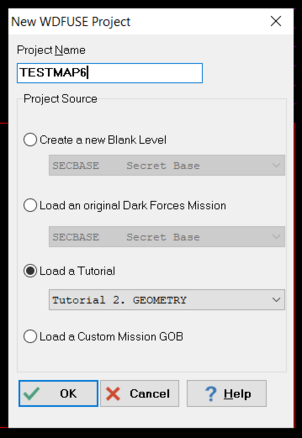
You will be greeted by many sectors with rooms connected via corridors. Each room will teach you something new about Dark Forces editing. All these lessons are quite important so make sure you understand and practice the concepts being taught. Please do this tutorial in order since each room's objective is based on completion of previous lessons.
Remember, if you make a mistake you can simply undo by using CTRL-Z. Also, you can always restart this tutorial by making a new project.
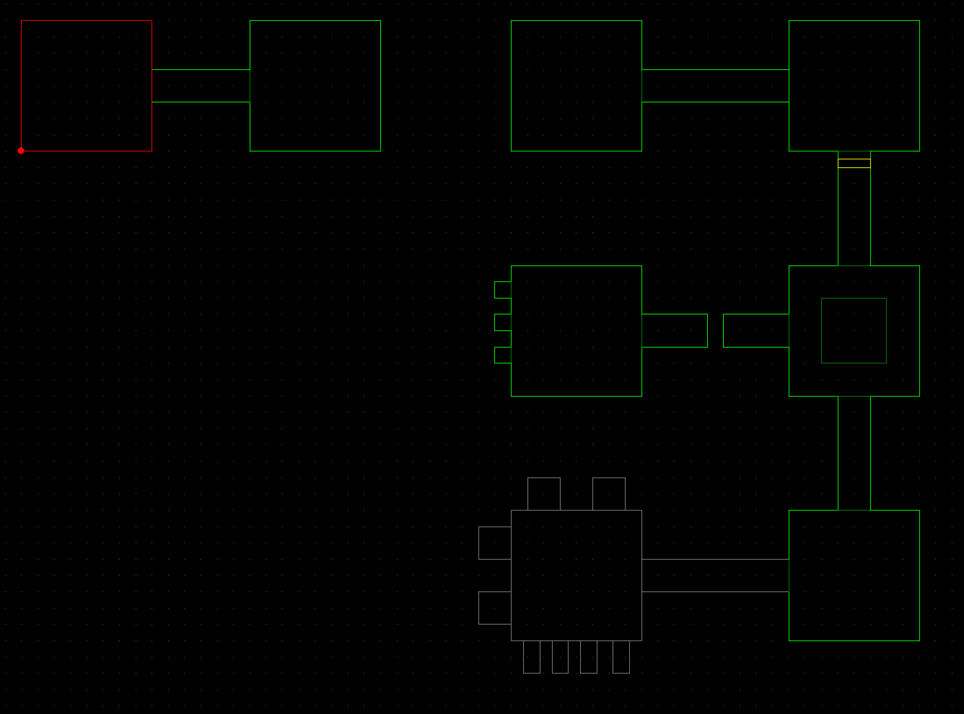
Testing your Map in Dark Forces
We are now at a point where we can start testing our mission. Once the tutorial is loaded press GOB in the top left corner or press CTRL-G. This process will take all the assets in your project directory, put them into a GOB called <PROJECT_NAME>.GOB and tell Dark Forces to launch it.
Note: This assumes you have already configured your Dark Forces Launcher (Steam / GOG / Origin / Custom) and Engine (JEDI / The Force Engine). If not, then press F9 to set it in the Options screen.
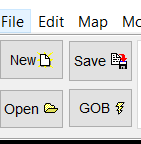
If you made any changes you may get prompted to Save your project. Say "YES" if that happens.
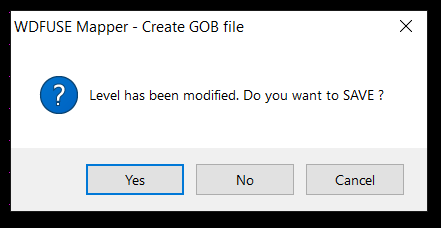
The game will launch and you will find yourself in the tutorial mission. There isn't much to do yet. You can run around between the two rooms connected by the corridor.
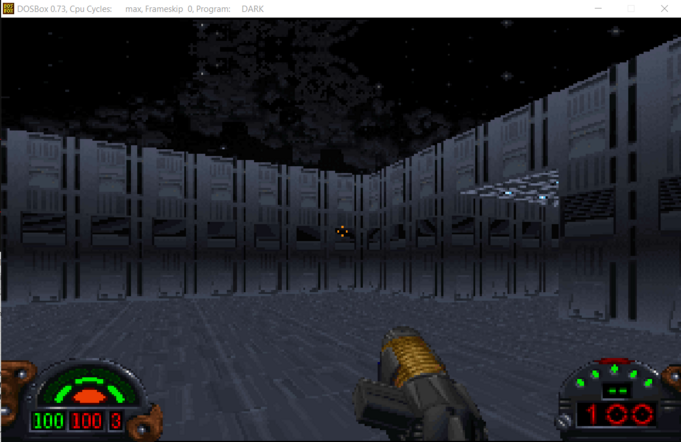
Once you confirm that the Dark Forces launches successfully, exit the game and go back to the WDFUSE editor.
Press F9 and switch to the tab "Backup & Launch" . Here you can see various settings that deal with launching the game.
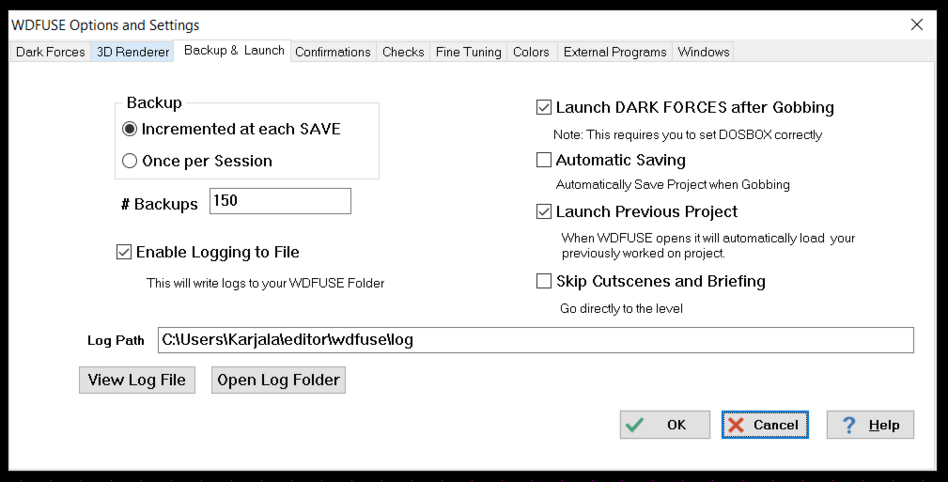
Notice that the editor makes a backup every time you save your project. They are stored in a BACKUP folder inside your project folder. You also have a LOG file you can look at for any issues. You can always bring up the current logfile by pressing F5 .
It is recommended you make two changes when you are working on your map.
- Enable Automatic Saving - this gets annoying very quickly and will stop prompting you every time you try to GOB the mission.
- Enable Skip Cutscenes and Briefing - this will allow you to instantly load into your mission without constantly showing your the cutscenes and the mission briefing (believe me - they get old quick!).
Once you have those two items checked, press OK to exit the options menu. Every time you make settings changes like this they get stored in a file called WDFUSE.INI inside your WDFUSE folder. If you ever want to wipe your setting and start form scratch simply delete that file.
Sector Overview
We had a brief overview of sectors before but now it is time to get into the details. When you select a room in the Sector Mode you will see a window popup that lists all the parameters of the sector.
Go ahead and select the top-left most sector where you start the tutorial.
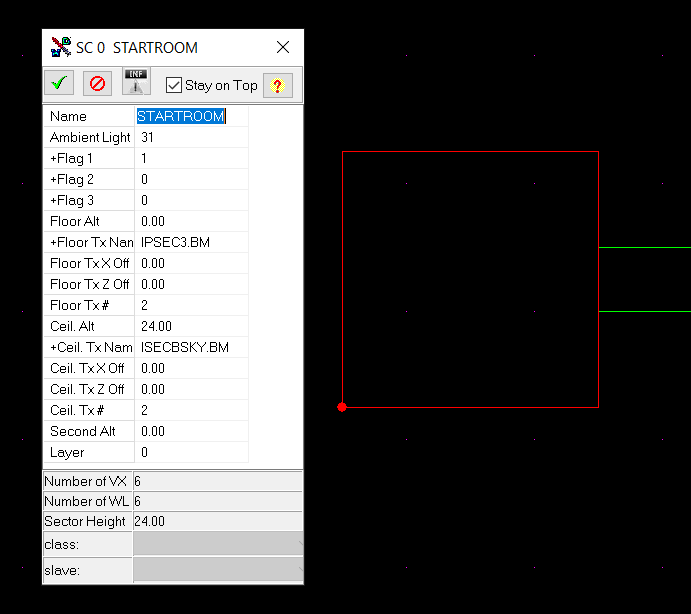
You will see the details of the selected sector that says SC 0 at the top. The 0 is the numerical ID of the sector. Dark Forces starts counting map components from 0. So if you have 10 sectors (or Walls, Vertices or Objects) in total they will be assigned numbers 0 through 9.
While all the sectors must have a number assigned to them, not all of them have a name. In this case this sector is called STARTROOM. Sector names make it easier to reference them when you start scripting and also is a helpful way to identify the sector's function.
Lets go over all the sector components.
- Name - Name of the Sector. This is Optional and can be left blank.
- Ambient Light - how bright a sector is. The number must be between 0 and 31 where 0 is total darkness and 31 is the brightest.
- Flag 1 - Grouping of flags that modify a sector's properties such as. This will be explained in detail later in the tutorial.
- Flag 2 - Unused. (Ignore for now)
- Flag 3 - Sets up custom lighting for the Talay Mission (Ignore for now).
- Floor Altitude - At what vertical position if the floor located at. The floor must always be below the ceiling!
- Floor Texture - Brings up the Texture Editor for the floor.
- Floor TX X Off - Configures the X-horizontal offset for the floor texture.
- Floor TX Z Off - Configures the Z-horizontal offset for the floor texture.
- Floor Tx # - Unused (Ignore for now)
- Ceiling Altitude - At what vertical position if the ceiling located at. The ceiling must always be above the floor!
- Ceiling TX X Off - Configures the X-horizontal offset for the ceiling texture.
- Ceiling TX Z Off - Configures the Z-horizontal offset for the ceiling texture.
- Ceiling Tx # - Unused (Ignore for now)
- Second Alt - Dark Forces supports one additional altitude on which you can walk. This is optional.
- Layer - What map layer this sector belongs to.
Lets go over the icons at the top.

- Whenever you make changes to the Sector (or any other Map Component like Walls) your changes must be saved. To do that click the Green Checkmark icon at the top or by pressing F3.
- You can cancel your changes by clicking the red circle next to it.
- The INF exclamation icon opens up the Scripting Editor - we will go over this in a later tutorial.
- You will also see a "Stay on Top" checkbox. If it is selected, this window will not be hidden when overlaid by the Map Editor. It's recommended to keep it checked.
- Finally, the question mark icon will bring up WDFUSE help.
Flags
Lets quickly explore the Flag Editor.
While having STARTSECTOR selected, try double-clicking on the Flag 1 option. This will bring up the Flag Edit menu.
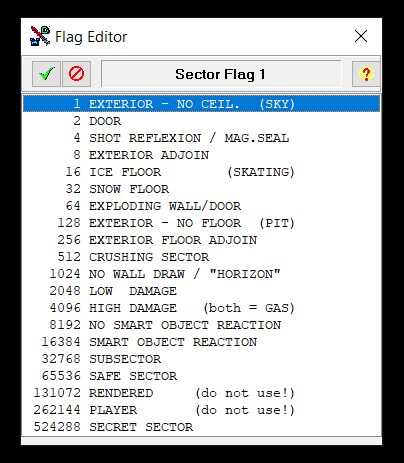
Flags are various options assigned to the Sector. In this particular case, the only option selected is the Exterior. This is because when you look outside you will see the sky. If that flag wasn't checked you will just see a flat texture as your ceiling. Exit out of this menu by pressing the X in the top right corner.
Just like flags, you can change a texture by double clicking on the texture parameter (Either Floor or Ceiling for a Sector). We will talk about that later in this tutorial.
Finding Sectors
To help you navigate , you can find a sector either by name or by numerical ID by pressing the F key. The search menu will popup allowing you to quickly find your sector.
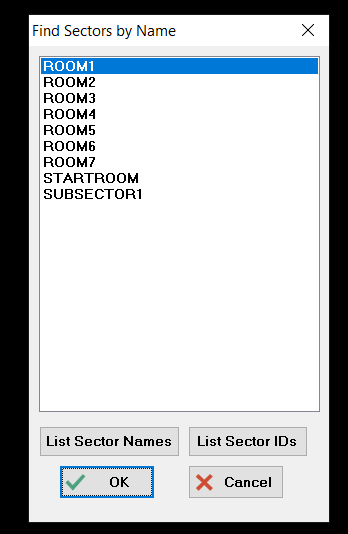
Walls
Vertices
Texture Editor
When you double click on a texture parameter in a Sector or Wall editor the Texture Resource Picker window will appear.
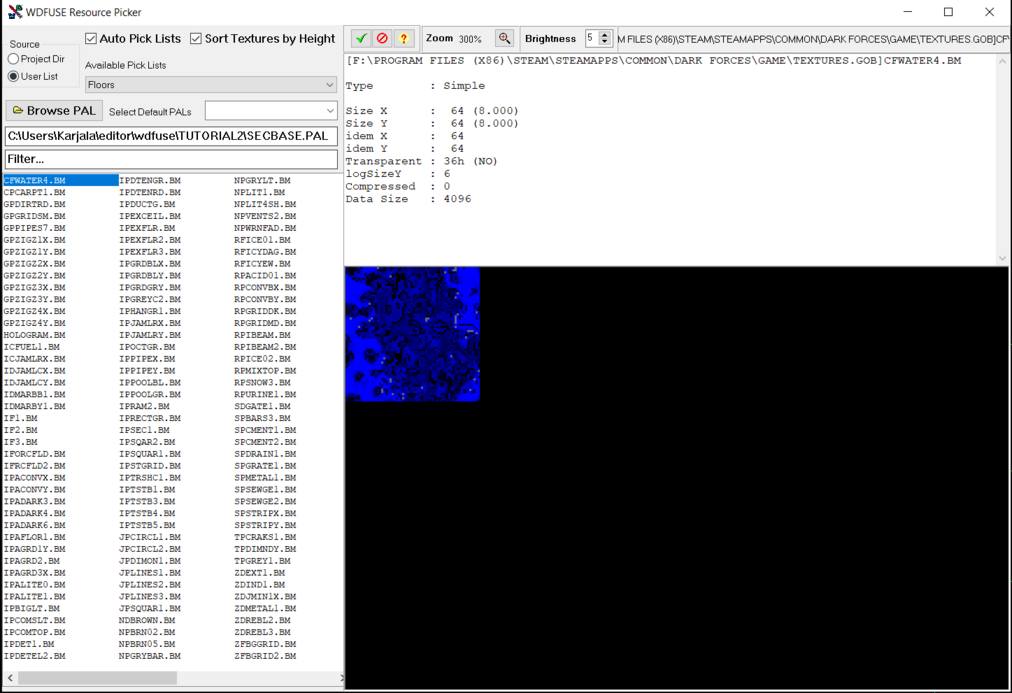
On the left you will see a list of textures. These are files that end in .BM and loaded from TEXTURES.GOB . When you pick the texture you like, the texture will be rendered in the window on the right. You will also have texture details explained in the top right corner such as the location, size and dimensions of the asset.
Notice that at the top you can also change the texture Brightness and the texture's Zoom level. So if the texture is too dark or too small you can always play with those settings to make it easier to view.
When you are done selecting your texture simply click the green checkmark at the top and your texture will be applied.
Filtering Textures
In the top left menu you can will see a Source option. Project Dir means that the textures are loaded from your WDFUSE project directory. Any BM file you put in that folder will appear in this list. User List means that the texture is loaded from TEXTURES.GOB .
You will also see a pull down called Available Pick Lists . These are nice groupings of textures to help you find the ones you need. You can search for a grouping of Walls, Ceilings or from an existing mission such as NARSHADA or IMPCITY
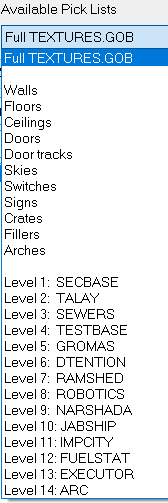
Clicking on the above will instantly filter the list at the bottom. You will also
Another way to easily find a texture you want is to use the filter bar above the texture list. While having "Full TEXTURES.GOB" selected in the Available Pick List try to find all the switches by typing "swi" . The textures will immediately show all the ones that contain that phrase.
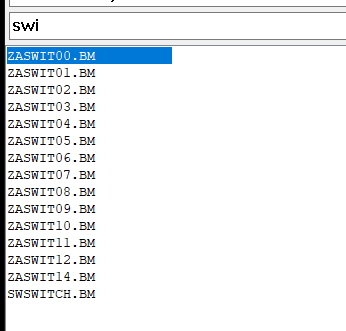
Palettes
A palette is a grouping of colors in Dark Forces. Because of the limits of the 1990s computer memory the game could only use a maximum of 256 colors per mission. A mission like Gromas Mines required a lot of red color gradients so it would use a special palette that has an emphasis on the color red. While a mission like Talay has an emphasis on moody purple colors. The palettes for each of those missions would be stored in GROMAS.PAL and TALAY.PAL files.
When you choose a different palette from the pulldown menu the texture on the right will instantly be rendered with the colors. Here is what CESUNSET.BM looks like when rendered with ROBOTICS.PAL
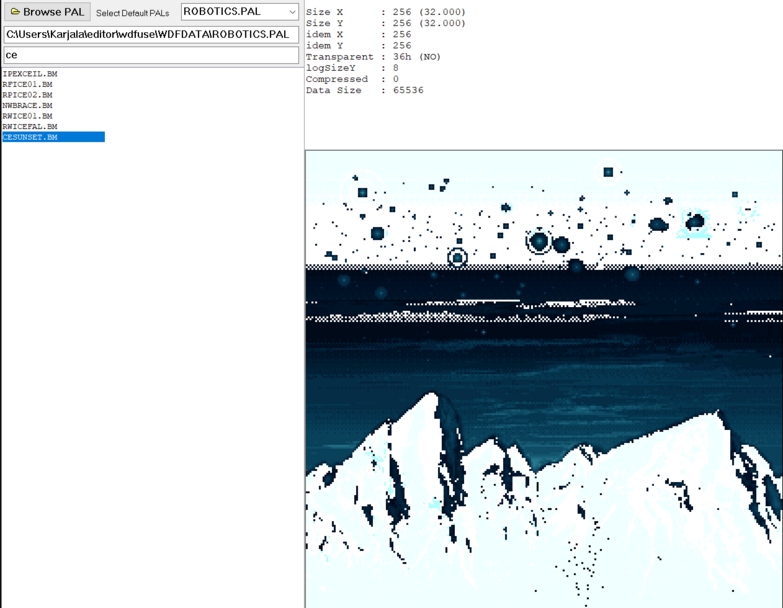
And this is what it looks like when using TALAY.PAL . It's a world of difference!
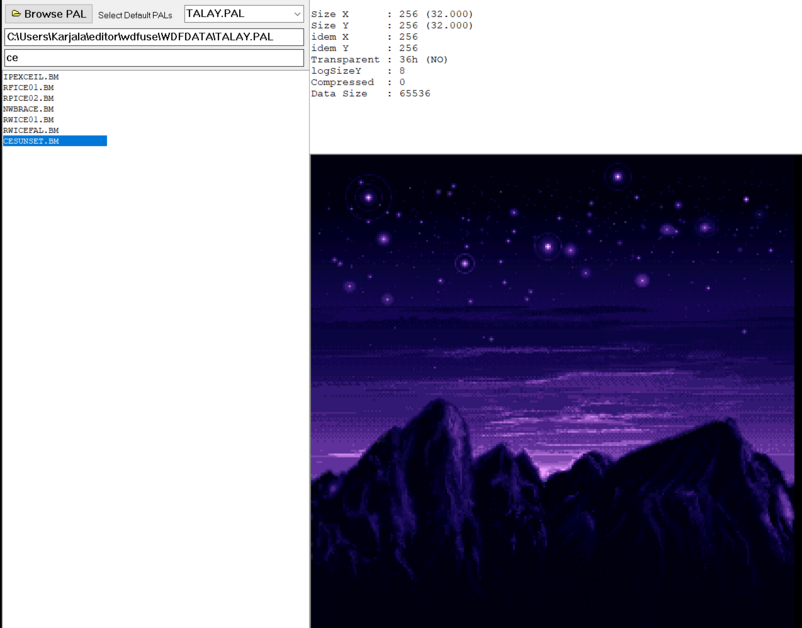
By default your mission will use the PAL from Secret Base but you can always change it in the level header editor. To access it, go back to the main editor window and go to View --> Editors --> LVL
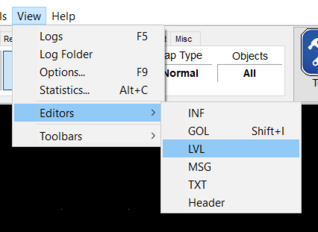
Here you can change SECBASE.PAL to another one.
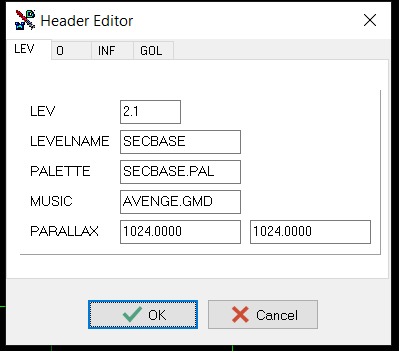
Remember, you can only have ONE palette per mission!
Automatic Texture Selection
In the top left corner you will see a number of checkboxes. The ones shown will differ depending if you open the texture from the Sector Editor or from a Wall Editor. Here is what the Wall Texture checkboxes look like.
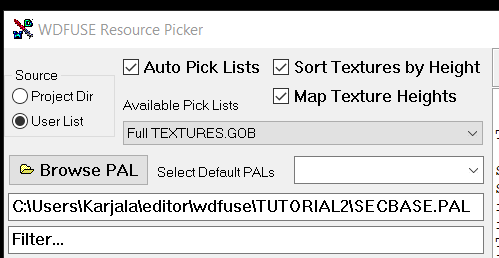
Here is the function of each one.
- Auto Pick Lists will automatically switch to a Floor or a Ceiling (or Sky) texture if you try to load the texture from the Sector Editor.
- Sort Textures by Height will sort all the textures from smallest to largest. This will only work on non-switch uncompressed textures .
- Map Texture Heights (This option is only available for Walls) will try to map the texture height to the height of the wall so it would fit perfectly.